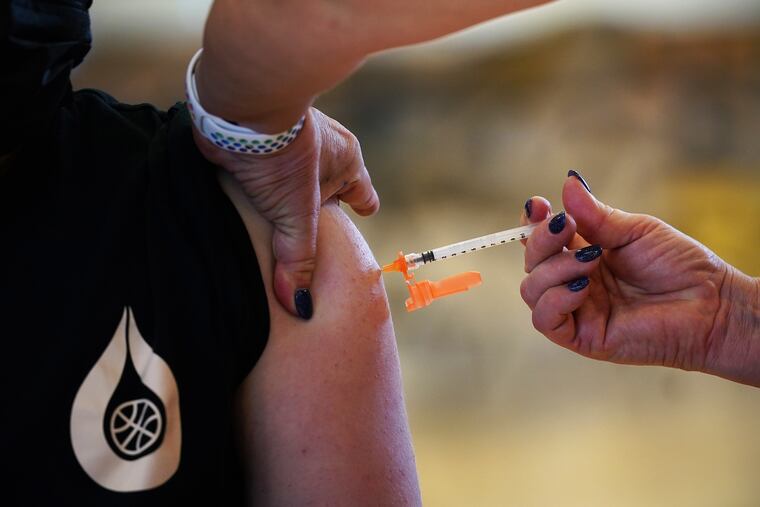Pa. vaccination doses were overcounted by 500,000 shots, state says
The Department of Health also said about 64,000 more people than previously reported were fully vaccinated.

More than 500,000 fewer coronavirus shots have been administered in Pennsylvania than the Department of Health had previously reported, the state said, partly because the department couldn’t properly track people who got vaccinated in two different places.
That means the number of people reported as having started the vaccination process dropped by more than half a million, while the true number of people who have been fully vaccinated increased by 64,000.
In addition to the tracking problem, the department on Monday blamed duplicate records for inflating the number of people who have been partially vaccinated.
The new data came a week after The Inquirer reported that one million Pennsylvanians were partially vaccinated and had missed their second shots, according to federal data. At the time, the Department of Health was not tracking whether people were skipping second shots, but a spokesperson said staffers were working to link first and second doses to the residents who received them.
Now, the Health Department says it has completed that work. The agency did not specify whether the data change was an effort to find the numbers it did not have available 10 days ago, but a spokesperson said Monday that the data now “more accurately reflects the number of people who have received the first of a two-dose vaccine.”
In total, 11.3 million doses have been administered in Pennsylvania, excluding Philadelphia, and 5.5 million people are fully vaccinated.
The data revision was included in a Friday evening press release without explanation for how the discrepancy happened or how it was detected. The state typically collects immunization data from vaccine providers, who are required to report the information to the state’s database.
The discovery of the discrepancy was made by Department of Health staff who have been working on verifying and cleaning the state’s data, spokesperson Mark O’Neill said Monday.
Duplicate vaccinations had been logged for various reasons: software used by some providers that did not log patients using unique identification numbers, some providers erroneously uploading duplicates when reporting data to the state, and people getting their first and second doses in different places, he said.
The correction was a one-time data reconciliation, and duplicates will not be included in Pennsylvania’s daily reported numbers in the future, O’Neill said. The Health Department has reported the change to the Centers for Disease Control and Prevention, though the federal agency’s data reporting will not immediately reflect the state’s correction.
State Rep. Tim O’Neal (R., Washington), a member of the state’s COVID-19 task force, said it was good news that the Department of Health had been able to audit the vaccination data — a task a team of 30 has been working on — and discover more people were fully vaccinated than known before.
“They recognized a couple months ago that ... it was pretty apparent that we were having this issue,” O’Neal said. “Now that the vaccination effort ... has slowed now to some degree, the ability to go back and audit that data to ensure it’s as accurate as possible has really presented itself.”
He said the state’s software was unable to identify someone who got their first and second doses from different providers as the same person, so it would record the patient as two different people.
» READ MORE: How many people in Pa. got vaccinated and still got COVID-19? The state isn’t counting.
Data reconciliation has been common throughout the pandemic, including with case and death counts. In June, the CDC found after data reviews that vaccination numbers were higher than previously reported in a handful of states, and 330,000 lower than reported in New Jersey. And on Monday, the governor of Utah said a reporting error meant the state had not actually reached 70% of adults with at least one dose, tweeting, “Welp. We screwed up.”
Data-keeping during the COVID-19 pandemic has presented a challenge for health departments; Pennsylvania health officials have said they were working with an aged technology system and hope to modernize the department’s data systems in the next fiscal year.
» READ MORE: Vaccines will stay key in guarding against the delta variant
In addition to not tracking detailed information about residents who have missed their second shots — the state was working with the CDC on linking data and resolving tracking challenges, spokespeople said last week — Pennsylvania also is not tracking all new infections among vaccinated residents, unlike some other states.
The state data do not include vaccinations administered in Philadelphia, which is running its immunization campaign independently. The data revision also updated demographic information of vaccine recipients. The Health Department statement and data dashboard did not provide updated numbers of administered first, single, and second doses.
Though the state’s numbers do not include any data for Philadelphia, the city’s data do use some state-reported numbers, health department spokesperson James Garrow said, meaning the city’s numbers could drop slightly as a result of the state’s new data.
City employees automatically and manually check Philadelphia’s vaccination data for duplicates in an established process, Garrow said, so health officials are confident their data are correct and do not contain large-scale duplication as the state’s database did.
Staff writer Jason Laughlin and graphic artist Chris A. Williams contributed to this article.